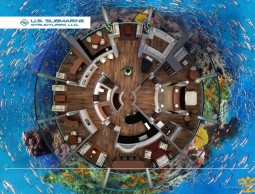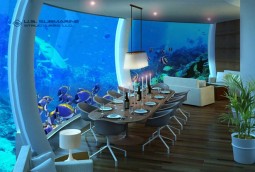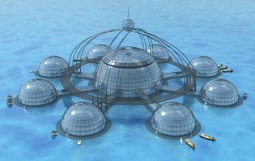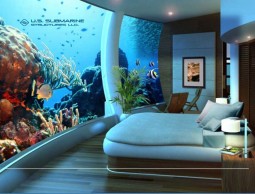Living by the Sea…What about Under it?
A few months ago I wrote about Semester At Sea’s university ship, the alternative to studying on land. For many the sea is an inviting part of the earth and a life living and studying on the sea seems like a possible alternative from living on dry land. This is an ancient way of living really, if you think about it, and many sea farers like Christopher Columbus, Vasco da Gama and Bartolomeu Dias, to mention only a few, made their way to continents far from their native homes. These great explorers and their intrepid crews could end up spending many months, sometimes years, on board of ships exploring the world.
These ships were kitted out with luxurious furniture (well for the officers, the crew had a somewhat different story!), and it was as good as relaxing at home. Indeed, the unfortunate class system on land found its replication on the open sea as he sailors were forced to live in very dirty conditions in the bow or stern area underneath the decks. Comparable to the slums of many countries on land where there is no proper sanitary facilities or proper building materials for homes protected against weather and the elements.

But what about living under the sea like the old Atlantians from the great Greek myths, does it appeal to future us, the future Atlantians? It would seem some of us are moving in this direction and a lot of technological advancement has been made in this regard. Companies are now creating homes and residences for the modern sea dweller under the surface of the water. You can now buy yourself a house under the sea and allow for your animals to function and survive deep under the water with you.
Sub-Biosphere 2 is a project, designed for the first self sustained underwater habitat that will allow for long term human, plant, and animal co-habitation. Phil Pauley, from Pauley Interactive, is the designer of this facility that will one day become home to humans, plants and animals, and will be a place for aquanauts, tourists and oceanographic life scientists to visit and explore.
The Sub-Biosphere is fitted with everything you would need to survive if you were human, plant or animal. There is fresh air, drinkable water, food, electricity and other resources. The atmospheric pressure that occurs under water at great depths is controlled by innovative new systems.
The Sub-Biosphere is made from interconnected living biomes, eight in total, and they are connected by tubes all leading to a centre biome that powers, controls and monitors the life systems within the other biomes from within its operations room. This structure operates like a lift and can sink and rise to the surface. Every biome has its own dock for ships to reach the Sub-Biosphere 2.
But if you are not quite sure if living that close to your neighbour is something you are ready for yet, you can always opt for the H2OME Undersea Residence. H2OME has been designed by a designer company called US Submarine Structures LLC. This new type of house allows you to watch the ocean outside your window, enjoy the fishes swimming and a traffic free environment with no horns and screeching tyres keeping you awake at night. Hotels have been put up under the water already and you will soon be able to buy these homes if you prefer a more private relaxing holiday.
You can choose if you want a sea-floor site or you can have an under-sea-location. If you are worried about getting there and the dangers involved with getting to your home, it is structured at surface pressure and you won’t need de-compression to keep you afloat. The homes are over 5000 sq. ft. big and feature dining rooms, bedrooms, kitchen areas, bathrooms and living room areas. Though you may not get AM radio…
These homes will most probably be put near coral reefs and quieter waters where there are plenty of tropical sea life and ocean activity. Oceans are unpredictable masses of water and this could be a cause for concern; tsunamis, tidal waves and storms are threats that one would anticipate when thinking of buying your new home. This could cause you a similar dilemma to the one you would face when investing in real estate on land.
Deciding if you would like to live at the base of an active volcano, live in a bad neighbourhood or buying that dream house in the richest and most glamorous neighbourhood on the hills, all involve many such dangerous factors like fires, guns and landslides. That school of fish has been hanging around a long time, I wonder what their up too…
But scientists have thought of it all and are very busy at solving such problems that might arise when buying estate under water. In Indonesia, they have a craft called the Floating Artificial Coral Reef Station and it is located in the Indian Ocean. It has been designed to protect the Indonesian coastline from tsunamis and it also supports the growth of natural coral reef. This Floating Artificial Coral Reef Station was designed by Margot Krasoiević.
Coral reefs are useful for many reasons; they build sand for beaches, can be harvested to make medicines and are a good breeding area for marine-life. The sea-craft is propelled by electricity with movable steel girders serving as a framework, and is connected to reef ball structures that help protect the ecosystems of coral reefs.
The whole station has been anchored into the ocean bed with flexible steel ties. This flexibility will allow the station to move slowly back and forward within the immediate environment and is adapted for shallow and deep corals. Eventually the coral will grow around the cables and stanchions that form the structure to create an artificial reef that will perform all the functions of a natural reef.
The electricity is necessary for creating electrical fields around the framework to make limestone skeletons. Limestone is derived from dissolved calcium carbonate that is condensed by the electric volts the cables are emanating and aids the development of natural coral. Even though this sounds dangerous for divers and fish to come in contact with, the electrical system is low enough not to cause electric shock to live tissue.
Healthy reefs have rougher surfaces and this slows down waves and prevents tsunamis to build up by slowing down the force of the waves. The reefs can also interfere with the distance a tsunami travels to get to land. The reef station has been based on geometrical patterns like Veroni patterns with textures especially designed to create the slowdown effect that will eventually phase the waves out.
It looks like living under water will be the future for many and a safe investment. There are many benefits to living under the sea for us as a human race. This could be the answer to over populated areas and using the space that is so vast to aid our ever growing population. It has been estimated that by the year 2040 the population will have grown to 9 billion and will continue growing till 2050. The present population when counted in 2011 stood at 7 billion.
That is a lot of people who will need homes and will have to be employed. Creating underwater trade (hotels, travel, sightseeing and construction of houses) and building underwater cities will help the economy as more business is generated and people are employed.
Maybe it is the future…anyone remember Sea Quest?











